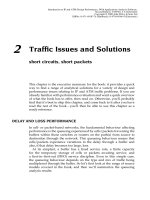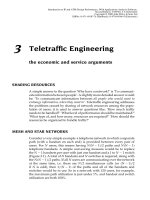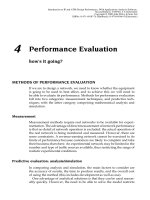Tài liệu Giới thiệu về IP và ATM - Thiết kế và hiệu suất P7 pdf
Bạn đang xem bản rút gọn của tài liệu. Xem và tải ngay bản đầy đủ của tài liệu tại đây (119.05 KB, 16 trang )
PART II
ATM Queueing and
Traffic Control
Introduction to IP and ATM Design Performance: With Applications Analysis Software,
Second Edition. J M Pitts, J A Schormans
Copyright © 2000 John Wiley & Sons Ltd
ISBNs: 0-471-49187-X (Hardback); 0-470-84166-4 (Electronic)
7
Basic Cell Switching
up against the buffers
THE QUEUEING BEHAVIOUR OF ATM CELLS IN OUTPUT
BUFFERS
In Chapter 3, we saw how teletraffic engineering results have been
used to dimension circuit-switched telecommunications networks. ATM
is a connection-orientated telecommunications network, and we can
(correctly) anticipate being able to use these methods to investigate the
connection-level behaviour of ATM traffic. However, the major difference
between circuit-switched networks and ATM is that ATM connections
consist of a cell stream, where the time between these cells will usually
be variable (at whichever point in the network that you measure them).
We now need to consider what may happen to such a cell stream as it
travels through an ATM switch (it will, in general, pass through many
such switches as it crosses the network).
The purpose of an ATM switch is to route arriving cells to the appro-
priate output. A variety of techniques have been proposed and developed
to do switching [7.1], but the most common uses output buffering. We
will therefore concentrate our analysis on the behaviour of the output
buffers in ATM switches. There are three different types of behaviour in
which we are interested: the state probabilities, by which we mean the
proportion of time that a queue is in a particular state (being in state k
means the queue contains k cells) over a very long period of time (i.e.
the steady-state probabilities); the cell loss probability, by which we mean
the proportion of cells lost over a very long period of time; and the cell
waiting-time probabilities, by which we mean the probabilities associated
with a cell being delayed k time slots.
To analyse these different types of behaviour, we need to be aware of
the timing of events in the output buffer. In ATM, the cell service is of
fixed duration, equal to a single time slot, and synchronized so that a cell
Introduction to IP and ATM Design Performance: With Applications Analysis Software,
Second Edition. J M Pitts, J A Schormans
Copyright © 2000 John Wiley & Sons Ltd
ISBNs: 0-471-49187-X (Hardback); 0-470-84166-4 (Electronic)
98
BASIC CELL SWITCHING
n − 1 nn + 1
A batch of cells arriving
during time slot n
Departure instant
for cell in service
during time slot n − 1
Time (slotted)
Departure instant
for cell in service
during time slot n
Figure 7.1. Timing of Events in the Buffer: the Arrivals-First Buffer Management
Strategy
enters service at the beginning of a time slot. The cell departs at the end
of a time slot, and this is synchronized with the start of service of the
next cell (or empty time slot, if there is nothing waiting in the buffer).
Cells arrive during time slots, as shown in Figure 7.1. The exact instants
of arrival are unimportant, but we will assume that any arrivals in a time
slot occur before the departure instant for the cell in service during the
timeslot.Thisiscalledan‘arrivals-first’ buffer management strategy. We
will also assume that if a cell arrives during time slot n, the earliest it can
be transmitted (served) is during time slot n C 1.
For our analysis, we will use a Bernoulli process with batch arrivals,
characterized by an independent and identically distributed batch of k
arrivals (k D 0, 1, 2,...)ineachcellslot:
ak D Prfk arrivals in a cell slotg
It is particularly important to note that the state probabilities refer to the
state of the queue at moments in time that are usually called the ‘end of
time-slot instants’. These instants are after the arrivals (if there are any)
and after the departure (if there is one); indeed they are usually defined
to be at a time t after the end of the slot, where t ! 0.
BALANCE EQUATIONS FOR BUFFERING
The effect of random arrivals on the queue is shown in Figure 7.2. For the
buffer to contain i cells at the end of any time slot it could have contained
any one of 0, 1,...,i C 1 at the end of the previous slot. State i can be reached
BALANCE EQUATIONS FOR BUFFERING
99
i
.
.
.
3
2
1
0
a(i-1)
a(i-2)
a(i)
a(i)
a(1)
a(0)
i + 1
i + 2
Figure 7.2. How to Reach State i at the End of a Time Slot from States at the End of
the Previous Slot
from any of the states 0 up to i by a precise number of arrivals, i down to
1 (with probability ai...a1) as expressed in the figure (note that not
all the transitions are shown). To move from i C 1toi requires that there
are no arrivals, the probability of which is expressed as a0; this then
reflects the completion of service of a cell during the current time slot.
We define the state probability, i.e. the probability of being in state k,as
sk D Prfthere are k cells in the queueing system at the end of any
ð time slotg
and again (as in Chapter 4) we begin by making the simplifying assump-
tion that the queue has infinite capacity. This means we can find the
‘system empty’ probability, s0 from simple traffic theory. We know
from Chapter 3 that
L D A C
where L is the lost traffic, A is the offered trafficandC is the carried
traffic. But if the queue is infinite, then there is no loss (L D 0), so
A D C
This time, though, we are dealing with a stream of cells, not calls. Thus
our offered traffic is numerically equal to , the mean arrival rate of
cells in cell/s (because the cell service time, s, is one time slot), and the
carried traffic is the mean number of cells served per second, i.e. it is the
utilization divided by the service time per cell, so
D
s
100
BASIC CELL SWITCHING
If we now consider the service time of a cell to be one time slot, for
simplicity, then the average number of arrivals per time slot is denoted
E[a] (which is the mean of the arrival distribution ak), and the average
number of cells carried per time slot is the utilization. Thus
E[a] D
But the utilization is just the steady-state probability that the system is
not empty, so
E[a] D D 1 s0
and therefore
s0 D 1 E[a]
So from just the arrival rate (without any knowledge of the arrival
distribution ak) we are able to determine the probability that the system
is empty at the end of any time slot. It is worth noting that, if the applied
cell arrival rate is greater than the cell service rate (one cell per time
slot), then
s0<0
which is a very silly answer! Obviously then we need to ensure that cells
are not arriving faster (on average) than the system is able to transmit
them. If E[a] 1 cell per time slot, then it is said that the queueing system
is unstable, and the number of cells in the buffer will simply grow in an
unbounded fashion.
CALCULATING THE STATE PROBABILITY DISTRIBUTION
We can build on this value, s0, by going back to the idea of adding all
the ways in which it is possible to end up in any particular state. Starting
with state 0 (the system is empty), this can be reached from a system state
of either 1 or 0, as shown in Figure 7.3. This is saying that the system can
be in state 0 at the end of slot n 1, with no arrivals in slot n,oritcanbe
in state 1 at the end of slot n 1, with no arrivals in slot n, and at the end
of slot n, the system will be in state 0.
We can write an equation to express this relationship:
s0 D s0 Ð a0 C s1 Ð a0
1
0
a(0)
a(0)
Figure 7.3. How to Reach State 0 at the End of a Time Slot
CALCULATING THE STATE PROBABILITY DISTRIBUTION
101
You may ask how it can be that sk applies as the state probabilities for
the end of time slot n 1andtimeslotn. Well, the answer lies in the fact
that these are steady-state (sometimes called ‘long-run’) probabilities,
and, on the assumption that the buffer has been active for a very long
period, the probability distribution for the queue at the end of time slot
n 1 is the same as the probability distribution for the end of time slot n.
Our equation can be rearranged to give a formula for s1:
s1 D s0 Ð
1 a0
a0
In a similar way, we can find a formula for s2 by writing a balance
equation for s1:
s1 D s0 Ð a1 C s1 Ð a1 C s2 Ð a0
Again, this is expressing the probability of having 1 in the queueing
system at the end of slot n, in terms of having 0, 1 or 2 in the system
at the end of slot n 1, along with the appropriate number of arrivals
(Figure 7.4). Remember, though, that any arrivals during the current time
slot cannot be served during this slot.
Rearranging the equation gives:
s2 D
s1 s0 Ð a1 s1 Ð a1
a0
We can continue with this process to find a similar expression for the
general state, k.
sk 1 D s0 Ð ak 1 C s1 Ð ak 1 C s2 Ð ak 2 CÐÐÐCsk 1
Ð a1 C sk Ð a0
which, when rearranged, gives:
sk D
sk 1 s0 Ð ak 1
k1
iD1
si Ð ak i
a0
1
0
2
a(0)
a(1)
a(1)
Figure 7.4. How to Reach State 1 at the End of a Time Slot









